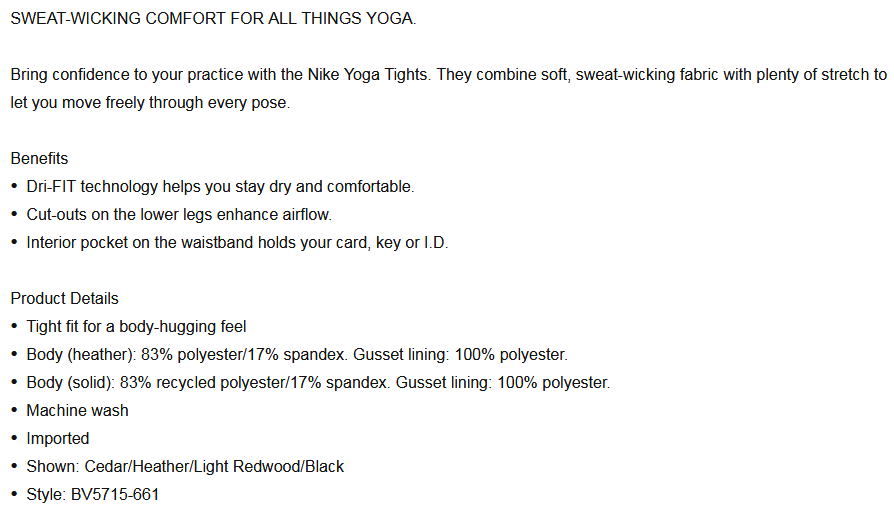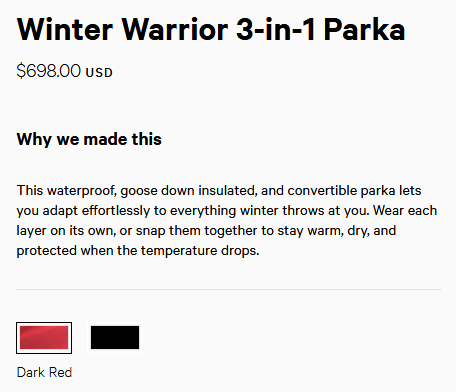Sell more with good product descriptions. (They have a considerable impact on conversions.)

What is a product description?
Product descriptions are the words you use to explain what a product is, what it does, and why customers should buy it. More importantly, a product description provides information about an item that photos can’t. And so it goes without saying that good product descriptions are essential for your online business.
Here’s why you need the best product descriptions
While it’s not the only determining factor, it can’t be denied that what you write can mean the difference between making the sale and the dreaded abandoned shopping cart.
Here’s what Salsify discovered:
- When deciding to make a purchase, 87% of consumers rate product content extremely or very important.
- Excluding price, product descriptions, ratings, and reviews are what influence customers to make a purchase—regardless of product category!
- 50% of shoppers have returned an item they bought online because it did not match the product description.
Those aren’t the only reasons why original product copy is so important for e-commerce. There are in fact strategic reasons – practical motivations – behind writing good product descriptions.
- SEO product descriptions contribute to how well a product page ranks on search engines. In other words, you need search-friendly copy in order for your brand to be discoverable online. Because if you’re not discoverable online, well, who’s going to buy from you?
- Quality product descriptions build trust with shoppers. Without trust there are no sales! The best product descriptions are informative, accurate, and complete. Here are a few product copy examples worth checking out.
- Product information is what persuades people that they must have the item—it moves consumers to take action.
All this to say, without high-quality product copy, how will a shopper know if what you’re offering is the answer to their needs? And what will convince them to buy from you? In other words, there’s a lot riding on your product descriptions.
How to write a product description
There are no ifs, ands, or buts about it: Great B2C and B2B product descriptions take time to write. You need to do your research, have SEO knowledge (as well as some basic SEO skills), and be a skilled writer. “Skilled” because there’s strategy involved; you’re not writing for fun. Your product copy has a purpose and a goal attached to it—it has to lead to sales.
How do you do that? Here’s what you need to know.
Product writing tips for product descriptions that sell
1. Know your target buyer
Effective product descriptions are equally enticing, so that customers want them, and convincing, so that customers must have them. The only way to do that is by knowing who your customers are (or will be).
Creating buyer personas can be really helpful. Who are your shoppers? Are they male or female? How old are they and where are they located? What makes them tick? And why might they want a product like yours?
The more you understand them, the better you can write for them.
2. Use clear, simple language
Product descriptions are not the place for flashy vocabulary—shoppers shouldn’t need a dictionary to understand what you’re selling.
If you want to keep your reader’s attention (and get them invested) then you need to:
Be accurate.
If you want to have credibility and a good reputation, then your product descriptions need to be factual. That is, people expect correct information about what you’re selling—otherwise they won’t be coming back any time soon (or ever).
Choose your words wisely.
Opt for terms that real people use every day. That works a lot better than jargon.
Keep sentences clean and concise.
You want product copy that’s easy to read and easy to understand.
Avoid spelling, grammar, and typographical errors.
Nothing screams unprofessional like sales and product copy riddled with 100% preventable mistakes. Seriously, there’s no excuse for not editing your work. You can self-edit your copy or go the easy route and hire me to clean your work up for you.
3. Consider length and format
Description length is a common concern. How long should it really be? Well, it depends partly on the product and partly on your audience. It also depends on if you have to justify the price tag.
For instance: Are you selling regular pencils or a tablet stylus specifically for digital sketching? Are your customers individual consumers or business clients?
What I can say for certain is that, aside from copy length, how you present product information really matters.

Some product descriptions are just a few sentences long. Others take up a full page. Some are broken down into multiple paragraphs while others rely on bullet points. Many, though, are a combination of both.
The point is, at the end of the day, your product copy has to be qualitatively good but also formatted to look good. In other words: It has to be reader-friendly.
4. List features, highlight benefits
If your description does nothing more than describe what can be seen, then you’re in trouble. Shoppers are human and that means you must appeal to both their rational and emotional sides. Covering a product’s features and benefits is the perfect way to do just that.

5. Don’t forget your keywords
To show up in search results, you’ll need to seamlessly integrate certain search terms into your copy. That means the words actual people use to search for your product category. You’ll also want to incorporate keywords in page titles, meta descriptions (for the all-important search snippet), and image tags for maximum impact.
6. Trim the fat
Are important product details buried in walls of text? Is your copy peppered with filler words? Have you gone overboard and listed every single product benefit?
Warning: No one wants to work that hard to figure out if an item is worth adding to cart. Focus on what’s most important and leave the rest out. There’s always the ‘more information’ section if you have more that needs to be shared.

7. Don’t use the manufacturer’s description
No matter how short on time (or lacking in inspiration) you are, it’s never a good idea to copy and paste descriptions from other sources. Google does not like duplicates. For the best results, put in the effort to write original copy or hire a product descriptions writer to do it for you. You won’t regret it!
Are creative product descriptions all you need to increase online sales?
I began this post with the reminder that product descriptions alone aren’t enough to boost conversions. The reality is that, on average, less than 2% of e-commerce website visits actually turn into a purchase.
That’s not all: The same Salsify research mentioned above found that 70% of shoppers need to see at least 3 product photos while shopping and 86% like to read at least 3 reviews.
Clearly multiple factors must work together harmoniously to result in sales.
Product copy aside, you also need professional photographs. Plus you have to earn customer trust, build in social proof, factor in search intent and the user’s purchase journey as well as optimize your online store for sales. Finally, you want to make sure customers don’t regret buying from you.
